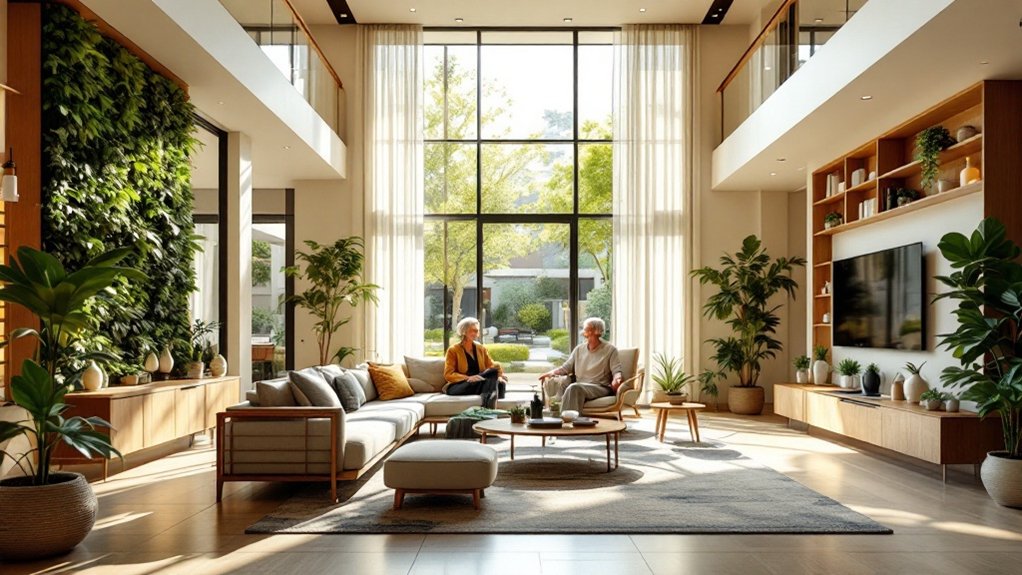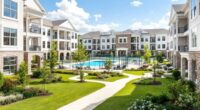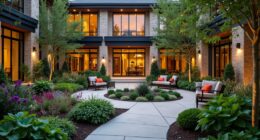You'll find senior living has transformed through technology integration and diverse housing models in 2025. Smart independent living communities feature AI-driven health monitoring, while 61% of providers now offer home-based services. Options include middle-market housing alternatives, co-housing arrangements, and specialized memory care facilities equipped with telehealth platforms and virtual reality applications. The integration of sustainable practices and personalized wellness programs makes today's senior living solutions more all-encompassing than ever before. Exploring these options reveals increasingly sophisticated approaches to aging well.

As the senior living industry undergoes a transformative shift toward technology-enabled, wellness-focused communities, the landscape of care options in 2025 reflects an unprecedented convergence of smart home integration, personalized healthcare delivery, and sustainable living practices.
You'll find thorough solutions incorporating AI-driven predictive analytics and telehealth platforms that enable proactive health monitoring while maintaining independence through voice-activated controls and smart home automation systems.
The integration of wearable devices and environmental sensors now provides real-time health data tracking, while virtual reality applications offer cognitive stimulation and social engagement opportunities.
You're able to access personalized wellness programs tailored to your specific health needs, complemented by brain-healthy interventions and physical activity initiatives that promote longevity and mental acuity through evidence-based protocols.
The market has responded to diverse financial requirements with the emergence of middle-market housing alternatives, including co-housing arrangements and group purchasing organizations that help manage costs amid inflationary pressures.
Advanced biophilic design elements create restorative environments that strengthen the connection between residents and nature.
You'll discover that solo aging considerations have prompted the development of specialized support services addressing both social connection and financial sustainability through innovative community structures.
Environmental consciousness permeates modern senior living facilities, with energy-efficient systems and eco-friendly materials reducing operational costs while appealing to environmentally aware residents.
You can participate in sustainability initiatives like community gardening programs that promote both environmental stewardship and social engagement among residents.
The culinary landscape has evolved to incorporate grab-and-go dining options alongside traditional social dining spaces, fostering community engagement while meeting diverse dietary preferences.
You'll experience adaptable living spaces designed to accommodate changing needs as you age, supported by intergenerational programs that combat isolation through meaningful cross-generational interactions.
The implementation of data-driven strategies guarantees that service offerings align with resident expectations, while regulatory frameworks through the Older Americans Act continue to advance healthy aging initiatives and economic security measures.
With home-based services becoming increasingly prevalent, 61% of not-for-profit life plan communities now offer these options to support aging in place preferences.
New caregiver support programs have been implemented to provide essential resources and training for family members and professional caregivers alike.
Frequently Asked Questions
How Do I Discuss Transitioning to Senior Living With My Aging Parents?
Start conversations about senior living early by scheduling dedicated family discussions to assess your parents' current needs, preferences, and concerns.
You'll want to research options together, focusing on communities that match their lifestyle while addressing future care requirements.
Consider involving healthcare providers or senior living advisors who can offer professional guidance, and emphasize how these communities enhance independence through personalized support services and amenities.
What Financial Assistance Programs Are Available for Senior Living Facilities?
You'll find multiple government assistance programs, including Housing Choice Vouchers (Section 8), which typically cover 70% of rental costs.
Section 202 Supportive Housing for seniors 62+ is also available. Medicaid can fund nursing home care in qualifying cases, while VA's Aid & Attendance program offers up to $2,229 monthly for eligible veterans.
Consider leveraging private options like long-term care insurance, reverse mortgages, or bridge loans while exploring state-specific subsidized housing initiatives.
Can Couples With Different Care Needs Live Together in Senior Communities?
You can live with your spouse in most senior communities through 2025's flexible care models, particularly in Continuing Care Retirement Communities (CCRCs) that accommodate varying needs under one campus.
While partners requiring memory care or skilled nursing may need separate living spaces, you'll find that 87% of facilities now offer hybrid arrangements where couples maintain proximity despite different care requirements, often through connected or adjacent units.
What Security Measures Are Standard in Modern Senior Living Facilities?
Modern senior living facilities implement multi-layered security protocols including electronic access control systems with key cards and fobs, thorough video surveillance with AI-enabled monitoring, and cybersecurity measures protecting residents' digital information.
You'll find enhanced safety features like slip-resistant flooring and strategically placed handrails, while medical alert systems and 24/7 wellness checks guarantee rapid response to emergencies, complemented by regular staff background screenings and encrypted data management systems.
How Often Can Family Members Visit Residents in Senior Living Communities?
You'll typically have access to visit your family members during standard hours of 9 AM to 9 PM, as mandated by Florida Statute 429, though specific facilities may adjust these parameters.
If you're designated as an essential caregiver, you'll receive expanded visitation privileges, particularly for end-of-life care or critical medical decisions.
Communities often require advance scheduling and health screenings, while maintaining flexibility for emergency situations and holiday accommodations.









